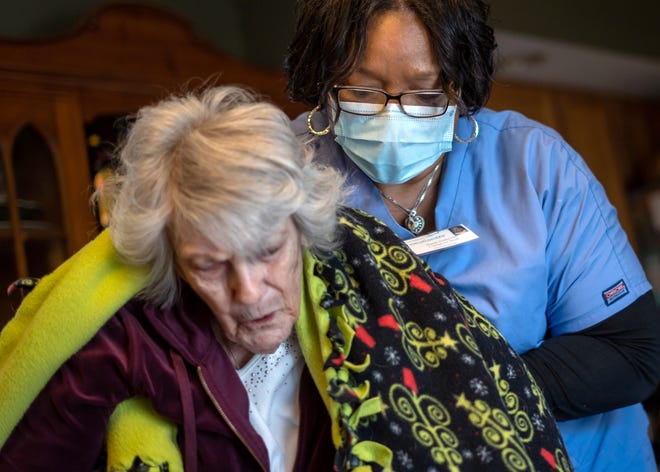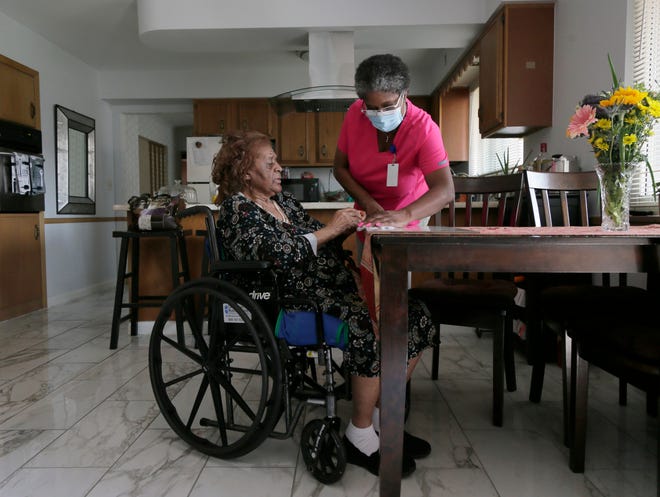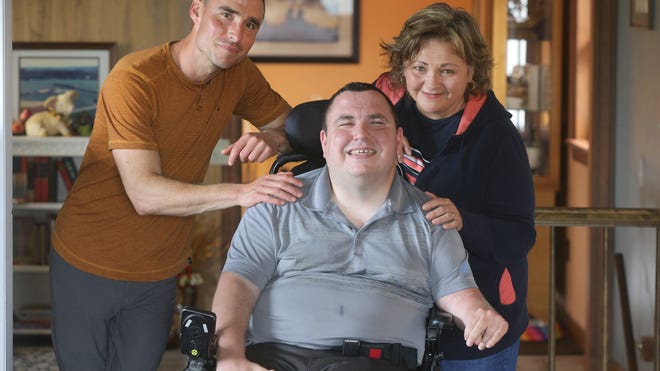If the scope of President Joe Biden’s social spending plan is too large to grasp, then consider Nancy Slomba of Western New York state.
She spends 84 hours a week caring for her son Joe Slomba, who has cerebral palsy and needs assistance to bathe, get in and out of bed and leave the family’s house.
The 59-year-old resident of a small Wyoming County town about 35 miles east of Buffalo gets paid $12.50 an hour to care for Joe through a New York state-based program. She and Joe’s twin brother, Ben, split the caregiving hours throughout the week.
But they’re making less per hour than they’d make working at McDonald’s. Joe’s care needs mean they can’t get other jobs, and there aren’t home care workers available in their rural county to share some of the caregiving duties.
“I’m exhausted,” Slomba said. “You’re not going to leave your family member, yet you’re not making enough money.”

Slomba is one of millions who care for their loved ones in the United States. In 2020, 48 million people in the U.S. provided unpaid care to an older adult or individual with health or functional needs. Many live in old industrial cities in places like Upstate New York and Michigan. A significant number are persons of color.
Those who cannot care for their loved ones themselves hire home care workers — a profession that is adding more new jobs than any other field in the American economy this year, but which struggles to attract and keep workers due to a dismal track record of low wages and scant benefits.
President Joe Biden made the untangling of this nationwide dilemma a top priority of his administration, earmarking a $400 billion chunk of his initial infrastructure agenda, titled the American Jobs Plan, to tackle home and community-based care. The funding would phase in over eight years.
The plan is two-fold; it would expand Medicaid to open up home care options for more families, and increase wages and benefit opportunities for 2.3 million home care workers in the U.S.
While Biden’s plan addresses some cries for policy change from caregivers and home care workers, it doesn’t necessarily carve a new path for home care — it addresses what has crippled long-term care across the country for years, like chronic underfunding and spending cuts, said C. Grace Whiting of the National Alliance for Caregiving, which supports family caregivers.
“This is more of a repair effort than a new direction,” she said.

Furthermore, the plan leaves out a large swath of middle-class families in its attempt to target the most impoverished, and does not clearly detail how it will funnel funding to the home care workers who need it most.
The New York & Michigan Solutions Journalism Collaborative, an endeavor involving a few dozen news organizations including the Detroit Free Press and Rochester Democrat and Chronicle, has vetted some of the solutions and shortcomings in the Biden caregiving plan.
Among the findings:
The fate of the plan remains uncertain as liberal and moderate Democrats in Congress struggle to find common ground.
The home care plan was excluded from a bipartisan version of the infrastructure bill passed by the U.S. Senate this summer. House Democrats are currently working to fashion legislation that would include some funding for home care — although amount of funding ultimately agreed upon may be far less than the proposed $400 billion.
Would expanding Medicaid open up home care options?
The proposal is supported by several bills at the federal and state levels, including the federal Better Care Better Jobs Act, which attempts to nail down specifics of Medicaid funding and home care employment reform.
Biden’s plan is “a once-in-a-generation investment,” said Ramsey Alwin of the National Council for the Aging. “Home care workers are underpaid and undervalued, and they have been incredible contributors to future generations.”
The plan is aimed at dissolving waiting lists for home and community-based services, or HBCS, through Medicaid; 820,000 individuals across the U.S. were waiting for HBCS waivers to cover professional or family-based home care services in 2018.
![[AP PHOTO/EVAN VUCCI/FILE]](https://www.gannett-cdn.com/presto/2021/10/01/NAAS/2e886c10-c58c-481d-8d9c-e2f443537d25-Biden_spending.jpg?width=660&height=440&fit=crop&format=pjpg&auto=webp)
Medicaid spending stood at $129 billion that year, with 56% of that going to home and community-based services.
These lists will likely grow in coming years. Half of all Baby Boomers are 65 and over and are rapidly increasing in their need for care as they age. This influx of older Americans will bring Medicare and Medicaid spending to $6.2 trillion by 2028, up from $3.8 trillion in 2019, the Centers for Medicare and Medicaid Services estimated.
Those on Medicaid could qualify for home care for age-related, physical, mental health or developmental reasons, and that care might cover assistance with personal needs such as housework, feeding, bathing, or physical or occupational therapy.
But enrollment caps and eligibility restrictions for HCBS waivers vary by state, with some states effectively shutting out most applicants, while other states accept more people but deal with massive backlogs.
Biden’s proposal under the infrastructure bill follows on a $12.7 billion commitment to home and community-based care services under the American Rescue Plan, a COVID-19 economic relief measure passed in the spring.
The Better Care Better Jobs Act, now under Senate committee review, would build on this funding, providing states with a permanent, 10-percentage point increase in Medicaid funding for HCBS if they meet certain criteria, including expanding financial eligibility for waivers.

“If there’s an infusion of funding for the Medicaid program, it would infuse more money into the home and community-based services system,” said Whiting of the National Alliance for Caregiving.
A key component of Biden’s plan is to save taxpayers money by reducing the amount of older Americans in nursing homes; in-home care has been shown to be much cheaper by comparison.
This fact has been proven, in part, by the federal Money Follows the Person program, which expanded access to Medicaid funds for home and community-based services for people transitioning out of institutional care.
Under the program, states have transitioned more than 101,000 people to community living from long-term care facilities and other institutions since 2008. It cut the Medicaid and Medicare bill for taxpayers by an estimated 23% per person moved out of a nursing home, federal records show.
Further expansion of Medicaid funding could fundamentally change Nancy Slomba’s tenuous financial situation. If she could be reimbursed more fairly for Joe’s care, he would have the option to continue getting care from family members while ensuring their financial stability.
“We need to make a living wage, and we’ve got loved ones who need us,” Slomba said. Another bill being considered in Congress, the Credit for Caring Act, could allow families like the Slombas to collect up to $5,000 in tax credits for their care efforts.
While the proposal could be beneficial to those on Medicaid, middle-class families whose loved ones don’t meet the asset threshold to qualify for Medicaid would be left with few cost-effective long term care options.
“Those folks who are not eligible for Medicaid right now don’t have that kind of support,” said Whiting of the National Alliance for Caregiving.

Medicare is limited in its coverage of home care. Only those recipients needing intermittent skilled nursing care or rehabilitation services like physical or occupational therapy can qualify for a Medicare-certified home health aide to provide personal services, like cooking or bathing.
This may force some families or older spouses to pay out of pocket for home care for a loved one, which can drain their savings and leave very few resources to care for their own needs after the loved one dies.
In this situation, especially in black and brown communities, adult children may quit their jobs or go part time to care for their parents or relatives, rather than try to hire a home care worker. This brings a different kind of stress as caregivers burn themselves out and cope with the difficulties of watching loved ones lose cognitive or physical function.
Programs and protections that could help these families include a broad paid family and medical leave proposal as part of a social safety net plan under debate in Congress, and programs like the National Family Caregiver Support Program, which offers support to family caregivers through community-based services across the U.S.
Families may also be forced to step in if home care workers are not available in their area — a problem that became increasingly acute during and after the COVID-19 pandemic.
Home care workers needed, industry facing labor shortage
In order to address the influx of Americans hitting age 75 in the next decade, the U.S. needs to form an army of home care workers — 4.7 million more of them, to be exact, by 2028. That doesn’t take into account a number of individuals with physical or developmental needs who require care.
The problems facing recruitment and retention in the industry are much closer at hand. Home care workers do some of healthcare’s most grueling work — caring for a person’s basic needs at all hours of the day and night, often in the face of a care recipient’s severe physical limitations or behavioral problems.

But these workers don’t make a living wage and don’t have access to the same benefits a nurse or nurse’s assistant might have. One in six home care workers live in poverty, according to the White House, with just over half being women in black and brown communities, according to a 2021 caregiving report from policy research firm PHI.
“We have a staffing crisis,” said Dana Arnone, owner/operator of Reliance Home Senior Services, a home care agency operating in Long Island and New York City. She also founded All Things Home Care, a nonprofit aimed at dissolving barriers that make home care work difficult, like lack of transportation to clients’ homes.
“When you have a worker problem, you have a business problem and then you have a healthcare problem with your patients,” she said.
Before COVID-19 hit, her agency had about 550 home care workers in its ranks; now, they’re down to 327. Some workers are fearful of catching the virus while others reevaluated their career path during the pandemic. The agency recently lost more workers who declined to be vaccinated, Arnone said.
‘These agencies didn’t have anybody’
The shortage threatens the safety of those like Sandra Moore-Giles, 75, of Kingston, who lives alone and needs assistance to shower, cook meals, take the garbage out, grocery shop, and ensure she makes it to the bathroom safely overnight.
She’s currently approved for 21 hours of home care per week through Medicaid; “But I can’t even find five hours per week,” she said.
She’s had aides in recent years, but often they’d come for only a few days or weeks before realizing that the pay is better in other fields, she said.
“They needed more money,” Moore-Giles said. “They would say, ‘Ms. Giles, they’re not paying me enough. I’m very sorry, but I’m not going to be able to do this.’”
Only one family member, Moore-Giles’ grandson, lives nearby, and he helps her when he’s able, she said. Otherwise, she showers without help, even though her doctors advised against it, and she avoids buying heavy items from the grocery store, because she doesn’t have anyone to help her carry them to her apartment.
“I am left without an aide — these agencies didn’t have anybody,” she said.
Joe Slomba, 36, whose mom and brother care for him nearly around the clock, is hoping he can find someone to help share the caregiving load.
“One of the things that I’m looking for is somebody to give my mom and my brother a break — (I’d like) to be able to have another attendant that I could hang out with, to help me get out in the community and get a job,” he said.
Are higher wages the answer?
Raising wages, as proposed in the federal home care plan, is one step in solving the staffing shortage puzzle. But other barriers make the home care profession unattractive, such as the public perception of the job, said Arnone of Reliance Home Senior Services.
“The wages dictate the professionalism. If you’re a minimum wage worker, people don’t always see you as a professional,” Arnone said. “But I will tell you the families that we care for, if those aides don’t show up, they themselves can’t go to work. It’s a domino effect.”
An additional hurdle for workers is transportation. On Long Island, it could take over an hour for a home care worker to travel to work via bus, depending on where their client is located. Arnone’s nonprofit, All Things Home Care, provides transportation to home care workers around the area using an Uber-style service.
Employees at Arnone’s home care agency are also represented by a union, which affords them paid time off, holidays and overtime pay. Unions have been key in saving home and community-based services from funding cuts across the country.
The United Domestic Workers of America union represents over 100,000 home care workers caring for residents under California’s In-Home Supportive Services Program, which aims to provide care to people at home rather than in nursing homes. They fought to preserve the program when its funding was threatened, said Kristina Bas Hamilton, formerly legislative director for the union and now an independent consultant.
“We all worked in coalition with the common goal to protect the program,” Hamilton said. “Whenever the state got into financial uncertainty, the proposal was always cut the program.”
If the workforce had not been unionized, Bas Hamilton said, IHSS would have been “catastrophically” cut.
A successful federal plan to increase support for the home care industry would ensure that higher wages, benefits and the ability to collectively bargain would trickle down to workers themselves, rather than getting caught up in bureaucracy, Arnone said.
“I would hope that the money gets to the workers, but I don’t believe that it will,” she said. “Even if you throw $20 an hour at the aide, you still have an issue of how you get them to where they need to go. It needs to be holistic.”
Includes reporting from Detroit Free Press reporter Eric Lawrence and USA Today Network New York reporter David Robinson.
Sarah Taddeo is an enterprise reporter for USA Today Network’s New York State Team. Got a story tip or comment? Contact Sarah at [email protected] or (585) 258-2774. Follow her on Twitter @Sjtaddeo. This coverage is only possible with support from our readers. Please consider becoming a digital subscriber.
About this project
This and related stories on the Biden administration’s caregiving plans are produced through the New York & Michigan Solutions Journalism Collaborative, a partnership of news organizations and universities dedicated to rigorous and compelling reporting about successful responses to social problems. The group, supported by the Solutions Journalism Network, has been producing stories on potential solutions to the challenges facing caregivers of older adults


